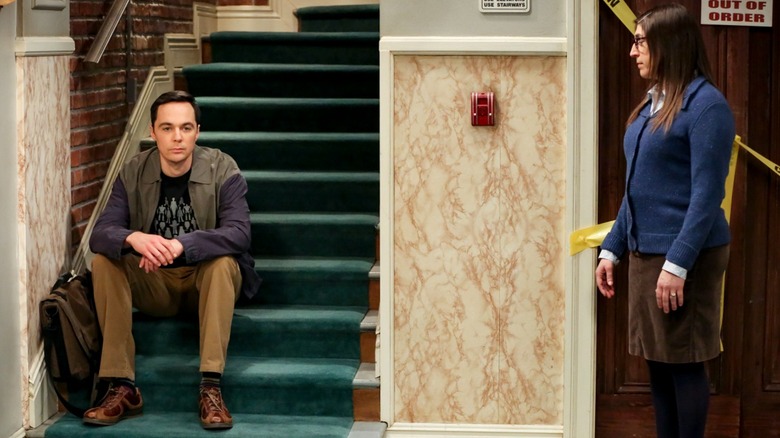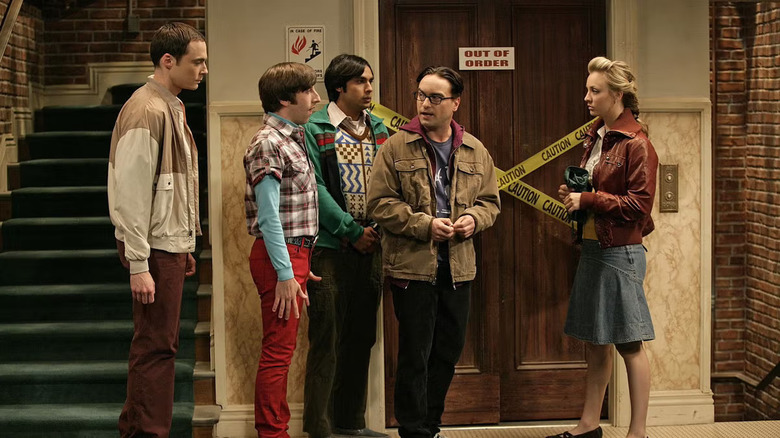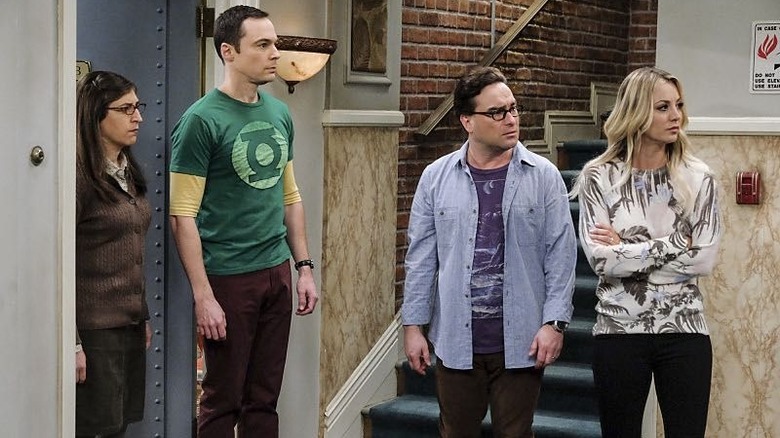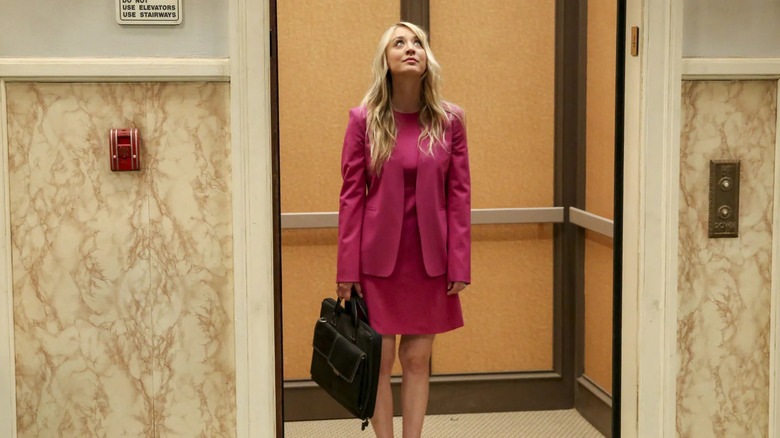The Truth About The Big Bang Theory Stairwell Scenes
Ever wondered exactly how the cast and crew of "The Big Bang Theory" filmed all those scenes where they trudged up and down the stairs in the apartment building where Sheldon Cooper (Jim Parsons), Leonard Hofstadter (Johnny Galecki), and Penny (Kaley Cuoco) all live? Kunal Nayyar, who survived studio interference and played Raj Koothrappali on the series, explained it, and it honestly sounds sort of irritating.
During a conversation on the British morning talk show Sunday Brunch in February of 2022 (per The Independent UK), Nayyar told host Tim Lovejoy that it's a simple albeit slightly stupid explanation. "The way it works is, you go down the stairs, and then they yell, 'Hold,'" Nayyar said before confirming that it's basically a single hallway. "They change the scenery from like, if the apartment says 1a it suddenly says 2a or 3. They change the set so it looks exactly like another floor."
As Nayyar explained to Lovejoy, it was just the one set of stairs, so the cast spent what seems like an inordinate amount of time running up a single staircase to prepare for the shot, walk "down" the stairs during the shot, and then repeat that over and over again. "You run back up the stairs, that go nowhere, and then you walk back down as if it's a new floor," he said. (Nayyar did, however, share a really gross tidbit about one of his co-stars when asked if there's anything past the bottom of the stairs: "Down there is nothing. There's a wall there where Johnny Galecki, for 12 years, would stick his chewing gum on. I'm not joking.")
Filming the stair scenes on The Big Bang Theory was really complicated
Wait — why did the cast of "The Big Bang Theory" constantly have to schlep up and down fake stairs? Well, within the universe of the show, the elevator is broken — which, according to Jessica Radloff's oral history "The Big Bang Theory: The Definitive, Inside Story of the Epic Hit Series," was a decision from creator Chuck Lorre that could help keep the action moving outside of sets like Leonard and Sheldon's apartment. Apparently, it was pretty tricky to shoot, especially because the show was famously one of the last major comedies to shoot in front of a live studio audience.
"Early on it was more difficult because they would write these stair scenes but you needed to time them whenever a character turned the corner," frequent director Mark Cendrowski revealed in the book. "Meaning you'd realize a line is so funny that you needed to move a couple lines to the next floor because the laugh was going to carry over to the next flight of stairs. But sometimes you couldn't have them walk that slow for the laugh, so it was a process. If we were really having trouble, we'd say to the writers, 'This is really funny, but we may need to shorten this," or "Maybe we need them to start on the second floor instead of the third floor.'"
While discussing the whole process, Cendrowski, perhaps unwittingly, confirmed exactly what Kunal Nayyar said about how the floors were constantly relabeled between shots. "And the set dressers had it down to a science," he recalled. "The numbers on the door changed, the tape went up, throw a bicycle out there. We also had a pipe on the second floor. I kept the cameras rolling usually when we'd go floor to floor because you didn't want to stop and cut and reslate and have to get the audience into it again. It was like, 'Nope, keep the roll, change it, here we go, third floor,' so they knew they were watching one scene."
Star Jim Parsons liked the whole broken elevator gag — and the stairwell conversations
So how did other cast members feel about the stairwell sequences? Kunal Nayyar didn't make it sound particularly appealing, but in Jessica Radloff's book, Jim Parsons said he felt they were a fun acting challenge thanks to the extremely precise timing — and, of course, the audience. "I did enjoy the stairway scenes. They're so physical, they're so technical, but that's part of comedy, so when they work, they're a high point of the evening," Parsons recalled. They offer you entrances and exits and the chance to say something just as you've gone out of view, which can be exceptionally funny to get that last line with nobody's face on-screen. But the hard part would be that you would have to time these, and how fast you walk, the pace you walk, the placement... it was very technical. And then no matter how you planned for it, so often the audience reaction would f*** it all up."
"I loved leaning that fully into such a theatrical device for a decade and two years," Parsons continued, saying that he understood the general reasoning behind the broken elevator — before saying that he was glad the show could get the "broken" elevator "fixed" as a piece of closure in the show's penultimate episode. "It's brilliant to me because there's a certain obnoxious quality to it, like, no we can't deliver good lines in an elevator that's closed," the Emmy winner said. "We have to have the stairs, so we're just going to break the elevator and keep it broken [...] There was no logical reason that the elevator shouldn't have been put back together! But to me, that's an element of good comedy, and it allowed us to have the elevator fixed in the last episode, which was so nice."
Ultimately, the elevator got fixed on The Big Bang Theory — to the delight of one of its stars
In the end, the creative team behind "The Big Bang Theory" made the (admittedly pretty funny) choice to "fix" the endlessly broken elevator in the season 12 episode "The Change Constant," the second-to-last episode of the entire show. In it, Sheldon is freaking out because everything in his life is changing too fast — he won a Nobel Prize in Physics alongside his wife Amy Farrah Fowler (Mayim Bialik) for their work on super-asymmetry and Amy got a makeover to celebrate, sending Sheldon into a complete spiral. To make matters "worse" (for Sheldon, anyway), he runs out of what's now Leonard and Penny's apartment to find Penny using the working elevator.
As Kaley Cuoco told Jessica Radloff in the book, she was really excited to find out that she got to use the elevator first. "When I found out I got to be in the elevator, that was it for me," Cuoco recalled, remembering when she first read the episode's script. "I was so excited. I could not wait to do it in front of the audience. In front of our producer run-through, it killed! People were screaming for all the reasons that you would."
"The Big Bang Theory," including all those stairwell scenes, is streaming on Max now.



